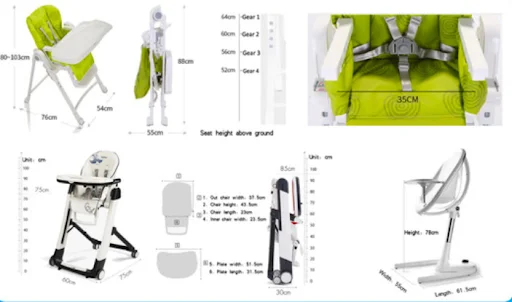The Baby Bed (Crib) is an essential product in the maternal and infant market, characterized by stable demand but fierce competition and high difficulty in product differentiation. For distributors and brand owners, the key to success lies in the ability to capture market trends in advance, adjust procurement, and optimize inventory strategies to avoid obsolescence in a rapidly evolving market.
The future crib market will be dominated by three major trends: “Tech-Enhanced Health and Safety,” “Multi-functional Longevity,” and “Home Aesthetic Integration.” These trends not only reflect the higher expectations of the new generation of parents but also point the way forward for supply chain innovation and strategic sourcing.
This article will provide an in-depth analysis of these key development directions, helping you secure a leading position in the 2025 competitive landscape.
Top pick of the day—our featured post delivers insight like no other.
Tech-Enhanced Health and Safety – The Convergence of “Smart” and “Zero Risk”
In the minds of the new generation of parents, “safety” has upgraded from a basic requirement to “smart safety.” They are eager to leverage technology to eliminate uncertainty during the parenting process.
The Proliferation of Sleep Environment Monitoring (Smart Safety)
- The market will see a surge in demand for smart mattresses and frames integrated with non-contact sensors. These technologies can monitor the baby’s breathing rate, temperature, and sleep position in real-time, providing immediate alerts via a smartphone application if abnormalities are detected.
- This smart safety system offers parents a “digital safety net” and is set to become a standard feature for mid-to-high-end crib products.
Material Evolution and the Health Focus
Beyond structural safety, indoor air quality and hygiene safety are becoming central concerns for parents:
- Low/Zero VOCs: Demand for advanced environmental certifications like GREENGUARD GOLD is no longer a bonus but a standard requirement for sourcing. Distributors must ensure that all procured paints, adhesives, and wood materials have undergone stringent testing for low volatile organic compounds.
- Anti-Bacterial and Anti-Mite: Emphasis is placed on anti-bacterial and anti-mite technologies in mattresses, bedding, and lining materials to safeguard the baby’s respiratory health and minimize allergens.
Facing technological upgrades, distributors should partner with R&D-capable suppliers to source wholesale baby bed products that meet future safety standards in bulk, ensuring their product line is market-forward and competitive.
Multi-functional Longevity – From “Crib” to “Growth Suite”
Modern parents seek maximum value for money and utilization. They want the crib to be more than a “short-term product” used for only a year or two; they expect it to be a “long-term investment” that accompanies their child’s growth.
Convertibility and Full Life-Cycle Value
- There is strong emphasis on full life-cycle conversion—from a Crib to a Toddler Baby Bed, a Day Bed, and even a functional Desk. This design meets parental demand for high-value, high-utilization products.
- Convertible crib designs require the manufacturer to provide robust and easy-to-operate conversion kits, ensuring the safety and stability of the product throughout the transition process.
Extreme Optimization of Space Efficiency
- Mini Cribs and Foldable Cribs will remain a hot topic for urban families. These products offer flexible storage solutions while maintaining the safety standards of a full-size crib.
- Integrated storage features will become mainstream. Designs like large under-bed drawers and side storage shelves cleverly solve the storage challenges faced by urban families, enhancing the product’s practicality.
The Continued Growth of Co-Sleeper Designs
- Demand for bedside sleepers (with adjustable height and one removable side rail) continues to grow. These products cater to the modern family’s need for intimate parenting while ensuring the baby’s safety through physical separation.
Home Aesthetic Integration – Driven by High Aesthetics and Customization
The crib is transitioning from a purely functional tool into an integral part of the home aesthetic. Parents expect the crib to blend seamlessly with the overall home style and reflect their unique taste.
The Fusion and Upgrade of Design Styles
- Minimalist and Nordic Styles: Simple lines, neutral tones, and high-quality solid wood or eco-friendly finishes remain the mainstream. The design trend is moving towards “invisible” baby furniture—items that look more like elegant pieces of adult furniture.
- Geometry and Lines: Headboards with unique geometric shapes or streamlined designs will appeal to young parents who prioritize design.
Value Enhancement Through Material and Tactile Feel
- Emphasis is placed on combining natural wood texture with eco-friendly finishes. The use of natural wood grain and high-quality textiles (such as organic cotton or linen) enhances the product’s visual and tactile value.
- Manufacturers must strike the optimal balance between the material’s eco-friendliness, tactile quality, and durability.
The Demand for Customization and Personalization
- Consumers are increasingly inclined to express their personality through customized color schemes, headboard shapes, or unique materials.
- To remain competitive, distributors must regularly update their supplier network, consulting a list of Chinese baby crib suppliers to partner with manufacturers who lead design trends and offer the latest technology support.
Supply Chain Strategy: The Distributor’s Response
In light of these trends, distributors and brand owners need to implement proactive strategic adjustments at the supply chain level:
- Procurement Strategy Adjustment: Increase procurement weight towards manufacturers with rapid ODM/OEM response capabilities. Future competition will be a race of design and iteration speed.
- Inventory Management Optimization: Optimize inventory structure by reducing the stockpiling of traditional, single-function models and increasing the proportion of convertible and smart products to adapt to changing market demand.
- Strategic Partnership: Encourage the establishment of R&D sharing partnerships with manufacturers. Leveraging the manufacturer’s experience in supply chain management and global certification allows for the co-development of products aligned with future safety trends, thereby lowering the distributor’s own R&D and compliance risks.
Conclusion
The 2025 baby bed market will be a perfect fusion of technology and design.
Distributors should act now, embracing the three major trends: Tech-Enhanced Health and Safety, Multi-functional Longevity, and Home Aesthetic Integration. Through precise sourcing decisions and strategic partnerships, ensure your product line not only meets current safety standards but also possesses future-oriented design and functionality, thereby securing a leading position in the fierce market competition and achieving sustainable business growth.






